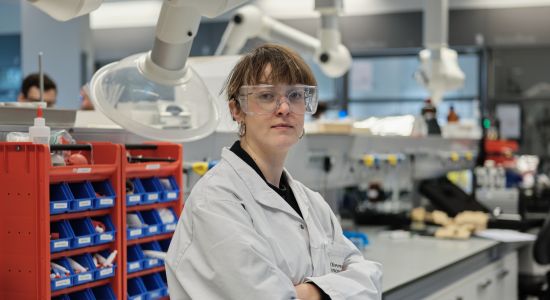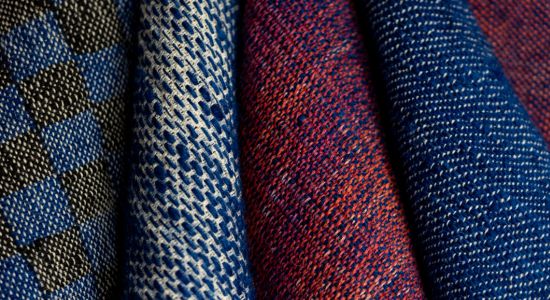Ecosystem instead of ego-system
Zsofia Kollar, now founder & CEO of Human Material Loop, studied design and architecture in the Netherlands. This programme included a focus on material science, examining how different materials are used in our living environment. She concluded that since our needs are constantly evolving — along with our lifestyles — the spaces we live in must also be flexible, adapting to various requirements. Given the environmental impact of the building industry (largest emitter of greenhouse gases), it is vital to incorporate sustainability and systems thinking into the design and use of building materials. Zsofia became deeply interested in new and alternative materials.
“The issue with the society is that we discard so many things so quickly — we can't afford this wastefulness anymore. How we build things needs to reflect who we are”
, she explains. She was particularly fascinated by how a single thread could form a large and robust structure.During her search for new materials, one in particular caught her attention: human hair.
“Once you have hair on your head, it’s so precious — you’ll spend any money, any time, to keep it. But once it’s cut, it loses all its value,”
says Zsofia. She began to wonder how the value of this material could be restored. After all, human hair has properties comparable to animal hair.Globally, about 2.2 billion kilograms of hair waste are produced annually in salons — an abundant and promising resource.Through networking events and workshops, Zsofia learned the steps needed to implement her still-vague idea, and which expertise and industry would be required. The textile industry made the most sense — it’s highly segmented, thoroughly researched, and a place where her innovation could make a meaningful impact. Through these events, she assembled a team of nine experts from diverse backgrounds, including a fibre engineer, organic chemist, finance impact measurement expert, and innovation lead. Together, they developed the steps necessary to turn human hair into a usable, valuable material.
One major challenge was inventing the technology to process raw hair into usable fibre; another was proving the concept’s economic viability to the public and the market. The unusual raw material raised questions — from cleanliness concerns to the fear of one´s DNA being involved in criminal investigations. There are strict regulations governing the sourcing and usage of human hair, which also lacks nuclear DNA (required for forensic identification).
According to Zsofia, the public's perception of the textile industry needs to shift.The idea of using human hair makes people uncomfortable — yet, discomfort should instead stem from recognizing the ethical and environmental issues in current practices. Textile supply chains are often unclear, having passed through many hands — some likely those of children.
“Somehow, we’ve become comfortable not knowing what happens to our garments. But transparency shocks people”
, Zsofia observes. Zsofia believes we’ve treated our environment for too long as an ego-system rather than an eco-system.People should be part of the equation — contributing to a responsible, circular usage of materials.That’s how the name of the start-up came to be: Human Material Loop.
Creating the fabric of life
Human Material Loop developed a chemical and mechanical processing method to transform human hair into usable fibre. The young company does not target the fashion industry directly, as fashion is marked by the short lifespan of its products. Instead, the team advocates for durability and longevity. Their current focus is on interior design — integrating the fibre into carpets, furniture, and noise-cancelling panels.
Human hair offers excellent qualities: thermal insulation, antibacterial properties, durability, and strength — thanks to its larger diameter compared to wool. It is also hypoallergenic and has strong noise-reduction capabilities. The material keeps its properties after processing.
The start-up employs two different Technologies to ensure a closed-loop system: One method semi-physically and semi-chemically alters the hair’s structure, making it compatible with existing textile machinery. The other breaks down keratin from the hair and extracts it to create a new filament via a wet-spinning process. The technology can process both dyed and undyed hair. To ensure a closed loop system, The waste generated by the first process serves as a valuable input for the second. Hair length is not an issue: shorter hair is used in extraction, while longer strands become staple fibre. The start-up found that their approach has 98 times less impact than cotton and 47 times less impact than wool in terms of global warming potential (measured in carbon emissions). Traditional materials require extensive chemical treatment across many processing steps.
"Compared to wool, which goes through 26 steps from sheep to usable fibre — washing, treating, scouring — our process takes just two”
, explains Zsofia. Human Material Loop is committed to a plastic- and toxin-free policy, using only biodegradable, environmentally friendly chemicals, eg. the salts used break down into non-persistent byproducts. Once the textiles are produced, they can be fully recycled and reintroduced into the system, contributing to a closed-loop lifecycle.Because hair is a natural byproduct of our existence, no cultivation or harvest is required.The company also saves significantly on emissions from transport by sourcing hair from local salons. They plan to build a European production hub where hair is collected and processed locally — before applying the same model to other continents. The goal is to keep the sourcing, production, and distribution loop as small as possible — creating long-lasting textiles that support a circular economy.
Next up at Human Material Loop
Currently, the start-up is preparing commercial pilot projects to test the viability of their material in real-world applications. As mentioned, their focus is on interior design — particularly acoustic panels and noise-reduction elements in commercial spaces. They are also scaling up production to meet growing demand.
In the long term, Human Material Loop aims to become a trusted supplier of alternative fibre — one that other companies can turn to when designing new products.
With their innovative approach, Human Material Loop, who joined the ISC3 Global Start-up Service October 2023, actively contributes to SDG6 (Clean Water and Sanitation), SDG9 (Industry, Innovation and Infrastructure), SDG12 (Responsible Consumption and Production) and SDG13 (Climate Action).




